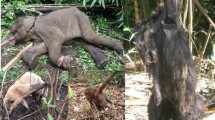Abstract
Trading wildlife is not a new phenomenon. Humans have been reliant on wildlife for food and shelter throughout history. It could be said then that the use of wildlife — both non-human animals and plants — is engrained within human cultures. This relationship with wildlife has led and is currently connected to the overexploitation of species. Historically, there is evidence of this overexploitation. For instance, in the US in the 1800s, both Atlantic Sturgeon and Shortnose Sturgeon were hunted for meat and caviar to such levels that by the early 1900s the populations had dropped severely and fishing was greatly reduced (Sweka et al. 2006). Populations began to recover and by 1980 commercial fishing operations of Atlantic Sturgeon were again at high levels (Sweka et al. 2006). This only lasted until 1996 when populations again fell, and a moratorium was placed on commercial and recreational fishing (Sweka et al. 2006). Fishing of the Shortnose Sturgeon only lasted until 1967, when it was listed on the Endangered Species Preservation Act (American Museum of Natural History 2010). Similarly, in New Zealand with the arrival of Europeans in the 1830s, pervasive logging of the native Kauri trees led to their populations greatly dwindling (Terra Nature 2003). Local construction, the exporting of logs, clearing for agriculture and fires have resulted in less than 1 per cent of the original forests surviving (Terra Nature 2003). Yet despite the clear loss of these forests, Kauri trees were not protected until 1973 (Terra Nature 2003).
Access this chapter
Tax calculation will be finalised at checkout
Purchases are for personal use only
Preview
Unable to display preview. Download preview PDF.
Similar content being viewed by others
Author information
Authors and Affiliations
Copyright information
© 2013 Tanya Wyatt
About this chapter
Cite this chapter
Wyatt, T. (2013). Introduction. In: Wildlife Trafficking. Critical Criminological Perspectives. Palgrave Macmillan, London. https://doi.org/10.1057/9781137269249_1
Download citation
DOI: https://doi.org/10.1057/9781137269249_1
Publisher Name: Palgrave Macmillan, London
Print ISBN: 978-1-349-44385-7
Online ISBN: 978-1-137-26924-9
eBook Packages: Palgrave Social Sciences CollectionSocial Sciences (R0)




